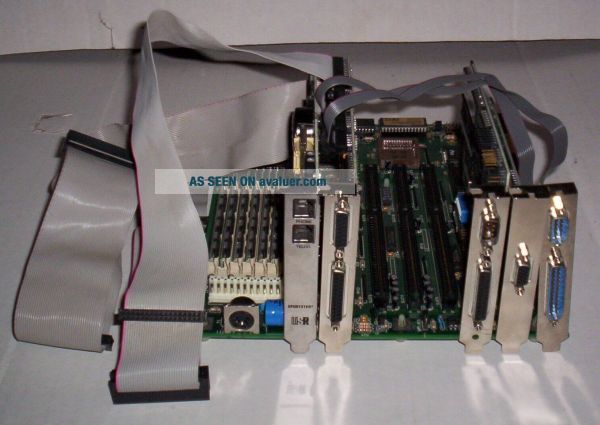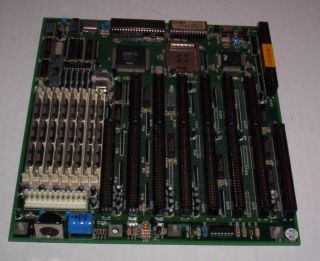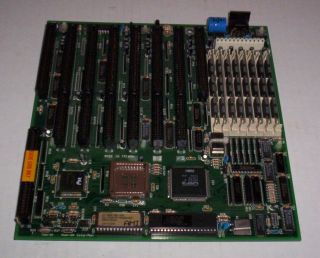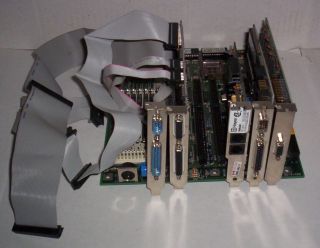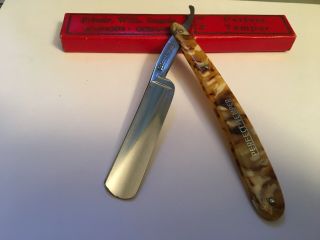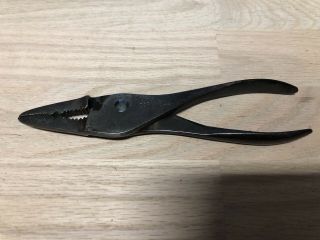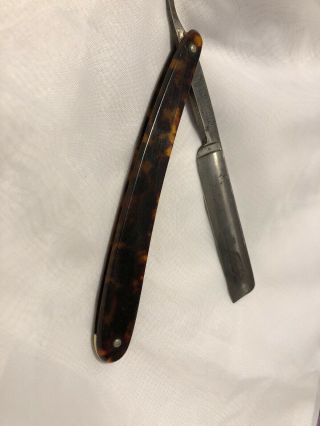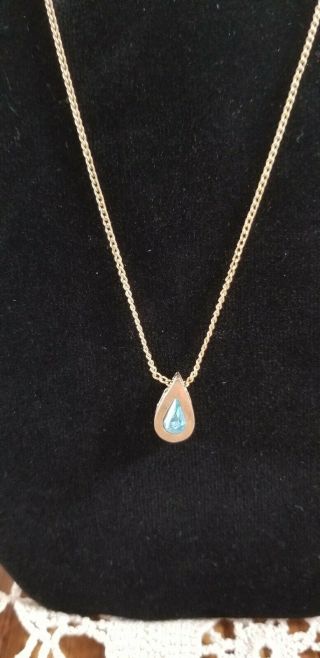Vintage Scat 386/16 Mobo W/ EV170 MIO, 144 Modem, CA8392 MIO, 512kb SVGA, Cable
Item History & Price
| Reference Number: Avaluer:27178948 | Type: Cable |
For sale is a vintage, near-pristine, fully-functioning, combo deal consisting of :
- SCAT 386/16 KMX-C-01 motherboard w/ Intel 386sx-16 + 8mb memory @ 70ns- Everex EV-170 8b MIO card @ COM1/3F8/I4 & LPT1/378/I7- US Robotics Sportster 14/14 8b int fax/modem card @ COM2/2F8/I3- CA8392 16b MIO card w/ COM3/3E8/I4, COM4/2E8/I3, LPT2/278/I7, GP, FDD & IDE- Vertex SVGA card w/ 512kb-70ns & feature connector- 1.44mb diskette w/ card/board layouts, jumper settings, etc
All i...tems are clean and in working condition, as they have been thoroughly tested repeatedly.
SCAT 386sx16 motherboard :
This SCAT motherboard is very clean and is powered by the CHIPs F82C836A T3C78 chipset and the AMI 386 BIOS (05/05/91). Via CheckIt, the maximum dhrystone achieved is 3400.
This motherboard has an Intel 386sx @ 16mhz, an NPU socket, and 8 ISA slots. There is no onboard "cache", but a "32kb Cache Card" can be inserted into the leftmost slot#8, which is proprietary for the 32kb card. This slot is followed by 6 16b ISA slots and an 8b ISA slot.
This motherboard has 8 30-pin SIMM slots, of which 8 1mb @ 70ns are installed for a total of 8mb. A total of 16mb can be installed, with 4 4mb SIMMs. The SIMMs are installed from left-to-right.
This motherboard can be trottled down to about 4.77mhz of the original IBM PC and XT. This can be accomplished by non-turbo mode, as well as resetting certain CMOS settings from their high-speed to low-speed.
Turbo / slow can be done via a turbo switch on the front of the computer, or by "ctrl.alt.+" for turbo and "ctrl.alt.-" for slow.
There is a "barrel" battery for date/time functions and the keeping of CMOS values. Considering its age, this battery has but a faint amount of leakage, as it is of the higher-quality kind. This battery still keeps a charge, but does loose time if the motherboard is not in use. If used daily, this battery should keep time sufficiently well.
There are 3 pages of CMOS SETUP settings. The 1st page is the usual. The 2nd page includes the regions of "Shadow ROM", in 32kb sections. 32kb of Video ROM at C000 is enabled, providing fast video response, and 64kb of System ROM at F000 is also enabled.
The 3rd page involves setting certain clock speeds :
Low CPU Clock Speed CXIN/8Bus Clock Select PROCLK/5DMA Clock Select BCLK/2Refresh Command Width 210 nsAdditional RAM Wait State Disabled
The "Low CPU Clock Speed" is the one that can mimick the 4.77mhz speed when in non-turbo mode, as well as disabling the shadowing of Video ROM and System ROM on the 2nd page.
The unused Shadow ROM areas can be utilized as UMBs, if using MS/PC-DOS's HIMEM.SYS and EMM386.EXE, or Novell/DRDOS's EMM386.EXE, or Quarterdeck's QEMM, or FreeDOS's JEMM386.EXE.
In using QEMM v9, the UMBs are as reported by Manifest :
- A000-AFFF 64k VGA Graphics- B000-B7FF 32k High RAM #1- B800-BFFF 32k VGA Text- C000-C7FF 32k Video ROM- C800-D7FF 64k Page Frame -- can be set otherwise in CONFIG.SYS- D800-EFFF 96k High RAM #2- F000-F5FF 24k System ROM- F600-F7FF 8k High RAM #3- F800-FFFF 32k System ROM
QEMM automatically uses the B000-B7FF and F600-F7FF ranges, as available on this motherboard, but might be a different arrangement on another motherboard. JEMM386 can also access open areas in the System ROM range, but must be told to by using the "include" option (eg, I=F600-F7FF).
Having as many UMBs available as possible is important for freeing up conventional memory by loading drivers and TSRs "hi" into the UMBs. In using PCDOS 7 with its well-designed capabilities, as much as 635kb of conventional memory can be made available!
Everex EV-170 card :
This card's SPa and PP are set to COM1 and 378/LPT1, respectively, and have been tested AOK via CheckIt and LapLink'ing to my main DOS system.
This card's SPb/COM2 could be activated by installing 16450, 1488, and 1489 chips in their respective sockets, then setting the DIPs accordingly, but instead, the modem uses COM2.
This arrangement of SPa/COM1 and modem/COM2 is beneficial for the older software, such as PFS: First Choice, that recognize only the first two COMx ports. Typically, then, a mouse is hooked up to COM1 and the modem to COM2, leaving COM3 and COM4 for other serial-based functions.
note: "Doesn't Work" is inked on the 16450 chip. In my tests, this card does work, or I would not include it in this deal. If you should have any problem with this card, let me know, and I will send you a free replacement.
US Robotics Sportster modem :
I don't have the means to test this modem by dialing, but CheckIt picks up on it, set at COM2/IRQ3. COMit also tests ok via its diagnostics.
In today's high-speed Internet connections, it may seem obsolete to include a dialing modem in this deal. But back in the day, dial-up bulletin boards were the sway. When the Internet took over, an untold number of these bulletin boards were melded into the Internet with seamless connectivity.
However, imagine the day coming when only those with yesteryear modems dialing into revived bulletin boards will be able to stay "online".
Note: This modem was selected, as opposed to other modems, because it fits in the 8-bit slot next to the barrel battery, as well as not interfering with the SIMM in the leftmost SIMM slot.
CA8392 MIO card :
This card's serial ports SPa and SPb are set to COM3 and COM4, respectively, and its parallel port is set to 278/LPT2. SPa/SPb/LPT have been tested AOK via CheckIt and LapLink'ing to my main DOS system. The game port has been tested AOK via CheckIt, with an attached game controller (not included). And the FDD and IDE have been tested with an attached 360kb drive and an IDE harddrive, respectively (neither included).
These extra serial and parallel ports can be used for any number of uses, such as a second printer or an external drive, or a LapLink cable.
Vertex SVGA card :
The Vertex card is powered by the Cirrus Logic GD5402 chip. This card has 512kb of VRAM at 70ns, providing rapid display and a full range of colors. The Vertex also has a feature connector, which I did not test.
Note: I tested several SVGA cards with the SCAT 386sx16 board, and the Vertex provided the best response. Not all video cards are created equal. As I have a large assortment of video cards, I can test which one(s) will respond best with a particular motherboard.
Summary & other notes
port assignments :
port: COM1/3F8/I4 - EV-170 8b MIO card COM2/2F8/I3 - USRobot 8b 144 fax/modem COM3/3EF/I4 - CA8392 16b MIO card COM4/2EF/I3 - CA8392 16b MIO card LPT1/378/I7 - EV-170 8b MIO card LPT2/278/I7 - CA8392 16b MIO card GP - CA8392 16b MIO card FDD - CA8392 16b MIO card IDE - CA8392 16b MIO card
possible motherboard slot layout :
slot#8 - open - 32kb cache card only - or SP c/DB9 + c/DB25 from 16b MIOslot#7 - Vertex 16b SVGA cardslot#6 - EV-170 8b MIO cardslot#5 - open - 16b network cardslot#4 - open - 8b PP card @ 3BCslot#3 - open - 16b CD/sound card w/ IDE portslot#2 - CA8392 16b MIO cardslot#1 - USRobot 8b 144 fax/modemcase - SP c/DB9 + c/DB25 from 16b MIO can go here in PC case port knockouts
note: Whatever 8b card might be inserted into slot#1, it's lowest / nearest-to-its-fingers components must be a safe distance above the SIMM right next to slot#1, for proper air flow of heat as well as to avoid shorting out the card with the SIMM.
note: CA8392's SP c/DB9 + SP c/DB25 could also be wrapped over to slot#8. Whereas a proprietary 32kb cache card would provide a throughput improvement, but not a significant enough one compared to an IDE harddrive with a decent amount of onboard cache.
note: If installing an IDE CDROM drive, it could be connected to the IDE channel of the CA8392, as a "slave". However, this might slow down response to the IDE harddrive. Instead, if installing a sound card, choose one with an IDE port. Connect the CDROM to this secondary IDE port, freeing up the IDE harddrive, as well as possibly installing a second IDE harddrive, on the CA8392. Also, with a secondary IDE port, another IDE-based device, such as a ZIP drive or Syquest drive, could be installed, in which the CDROM would be as a slave.
These items are being offered in "as is" condition.
Please email me for any other questions or considerations. Thank you.
- SCAT 386/16 KMX-C-01 motherboard w/ Intel 386sx-16 + 8mb memory @ 70ns- Everex EV-170 8b MIO card @ COM1/3F8/I4 & LPT1/378/I7- US Robotics Sportster 14/14 8b int fax/modem card @ COM2/2F8/I3- CA8392 16b MIO card w/ COM3/3E8/I4, COM4/2E8/I3, LPT2/278/I7, GP, FDD & IDE- Vertex SVGA card w/ 512kb-70ns & feature connector- 1.44mb diskette w/ card/board layouts, jumper settings, etc
All i...tems are clean and in working condition, as they have been thoroughly tested repeatedly.
SCAT 386sx16 motherboard :
This SCAT motherboard is very clean and is powered by the CHIPs F82C836A T3C78 chipset and the AMI 386 BIOS (05/05/91). Via CheckIt, the maximum dhrystone achieved is 3400.
This motherboard has an Intel 386sx @ 16mhz, an NPU socket, and 8 ISA slots. There is no onboard "cache", but a "32kb Cache Card" can be inserted into the leftmost slot#8, which is proprietary for the 32kb card. This slot is followed by 6 16b ISA slots and an 8b ISA slot.
This motherboard has 8 30-pin SIMM slots, of which 8 1mb @ 70ns are installed for a total of 8mb. A total of 16mb can be installed, with 4 4mb SIMMs. The SIMMs are installed from left-to-right.
This motherboard can be trottled down to about 4.77mhz of the original IBM PC and XT. This can be accomplished by non-turbo mode, as well as resetting certain CMOS settings from their high-speed to low-speed.
Turbo / slow can be done via a turbo switch on the front of the computer, or by "ctrl.alt.+" for turbo and "ctrl.alt.-" for slow.
There is a "barrel" battery for date/time functions and the keeping of CMOS values. Considering its age, this battery has but a faint amount of leakage, as it is of the higher-quality kind. This battery still keeps a charge, but does loose time if the motherboard is not in use. If used daily, this battery should keep time sufficiently well.
There are 3 pages of CMOS SETUP settings. The 1st page is the usual. The 2nd page includes the regions of "Shadow ROM", in 32kb sections. 32kb of Video ROM at C000 is enabled, providing fast video response, and 64kb of System ROM at F000 is also enabled.
The 3rd page involves setting certain clock speeds :
Low CPU Clock Speed CXIN/8Bus Clock Select PROCLK/5DMA Clock Select BCLK/2Refresh Command Width 210 nsAdditional RAM Wait State Disabled
The "Low CPU Clock Speed" is the one that can mimick the 4.77mhz speed when in non-turbo mode, as well as disabling the shadowing of Video ROM and System ROM on the 2nd page.
The unused Shadow ROM areas can be utilized as UMBs, if using MS/PC-DOS's HIMEM.SYS and EMM386.EXE, or Novell/DRDOS's EMM386.EXE, or Quarterdeck's QEMM, or FreeDOS's JEMM386.EXE.
In using QEMM v9, the UMBs are as reported by Manifest :
- A000-AFFF 64k VGA Graphics- B000-B7FF 32k High RAM #1- B800-BFFF 32k VGA Text- C000-C7FF 32k Video ROM- C800-D7FF 64k Page Frame -- can be set otherwise in CONFIG.SYS- D800-EFFF 96k High RAM #2- F000-F5FF 24k System ROM- F600-F7FF 8k High RAM #3- F800-FFFF 32k System ROM
QEMM automatically uses the B000-B7FF and F600-F7FF ranges, as available on this motherboard, but might be a different arrangement on another motherboard. JEMM386 can also access open areas in the System ROM range, but must be told to by using the "include" option (eg, I=F600-F7FF).
Having as many UMBs available as possible is important for freeing up conventional memory by loading drivers and TSRs "hi" into the UMBs. In using PCDOS 7 with its well-designed capabilities, as much as 635kb of conventional memory can be made available!
Everex EV-170 card :
This card's SPa and PP are set to COM1 and 378/LPT1, respectively, and have been tested AOK via CheckIt and LapLink'ing to my main DOS system.
This card's SPb/COM2 could be activated by installing 16450, 1488, and 1489 chips in their respective sockets, then setting the DIPs accordingly, but instead, the modem uses COM2.
This arrangement of SPa/COM1 and modem/COM2 is beneficial for the older software, such as PFS: First Choice, that recognize only the first two COMx ports. Typically, then, a mouse is hooked up to COM1 and the modem to COM2, leaving COM3 and COM4 for other serial-based functions.
note: "Doesn't Work" is inked on the 16450 chip. In my tests, this card does work, or I would not include it in this deal. If you should have any problem with this card, let me know, and I will send you a free replacement.
US Robotics Sportster modem :
I don't have the means to test this modem by dialing, but CheckIt picks up on it, set at COM2/IRQ3. COMit also tests ok via its diagnostics.
In today's high-speed Internet connections, it may seem obsolete to include a dialing modem in this deal. But back in the day, dial-up bulletin boards were the sway. When the Internet took over, an untold number of these bulletin boards were melded into the Internet with seamless connectivity.
However, imagine the day coming when only those with yesteryear modems dialing into revived bulletin boards will be able to stay "online".
Note: This modem was selected, as opposed to other modems, because it fits in the 8-bit slot next to the barrel battery, as well as not interfering with the SIMM in the leftmost SIMM slot.
CA8392 MIO card :
This card's serial ports SPa and SPb are set to COM3 and COM4, respectively, and its parallel port is set to 278/LPT2. SPa/SPb/LPT have been tested AOK via CheckIt and LapLink'ing to my main DOS system. The game port has been tested AOK via CheckIt, with an attached game controller (not included). And the FDD and IDE have been tested with an attached 360kb drive and an IDE harddrive, respectively (neither included).
These extra serial and parallel ports can be used for any number of uses, such as a second printer or an external drive, or a LapLink cable.
Vertex SVGA card :
The Vertex card is powered by the Cirrus Logic GD5402 chip. This card has 512kb of VRAM at 70ns, providing rapid display and a full range of colors. The Vertex also has a feature connector, which I did not test.
Note: I tested several SVGA cards with the SCAT 386sx16 board, and the Vertex provided the best response. Not all video cards are created equal. As I have a large assortment of video cards, I can test which one(s) will respond best with a particular motherboard.
Summary & other notes
port assignments :
port: COM1/3F8/I4 - EV-170 8b MIO card COM2/2F8/I3 - USRobot 8b 144 fax/modem COM3/3EF/I4 - CA8392 16b MIO card COM4/2EF/I3 - CA8392 16b MIO card LPT1/378/I7 - EV-170 8b MIO card LPT2/278/I7 - CA8392 16b MIO card GP - CA8392 16b MIO card FDD - CA8392 16b MIO card IDE - CA8392 16b MIO card
possible motherboard slot layout :
slot#8 - open - 32kb cache card only - or SP c/DB9 + c/DB25 from 16b MIOslot#7 - Vertex 16b SVGA cardslot#6 - EV-170 8b MIO cardslot#5 - open - 16b network cardslot#4 - open - 8b PP card @ 3BCslot#3 - open - 16b CD/sound card w/ IDE portslot#2 - CA8392 16b MIO cardslot#1 - USRobot 8b 144 fax/modemcase - SP c/DB9 + c/DB25 from 16b MIO can go here in PC case port knockouts
note: Whatever 8b card might be inserted into slot#1, it's lowest / nearest-to-its-fingers components must be a safe distance above the SIMM right next to slot#1, for proper air flow of heat as well as to avoid shorting out the card with the SIMM.
note: CA8392's SP c/DB9 + SP c/DB25 could also be wrapped over to slot#8. Whereas a proprietary 32kb cache card would provide a throughput improvement, but not a significant enough one compared to an IDE harddrive with a decent amount of onboard cache.
note: If installing an IDE CDROM drive, it could be connected to the IDE channel of the CA8392, as a "slave". However, this might slow down response to the IDE harddrive. Instead, if installing a sound card, choose one with an IDE port. Connect the CDROM to this secondary IDE port, freeing up the IDE harddrive, as well as possibly installing a second IDE harddrive, on the CA8392. Also, with a secondary IDE port, another IDE-based device, such as a ZIP drive or Syquest drive, could be installed, in which the CDROM would be as a slave.
These items are being offered in "as is" condition.
Please email me for any other questions or considerations. Thank you.



